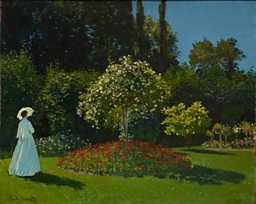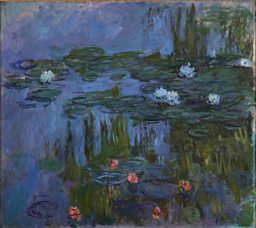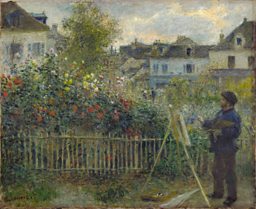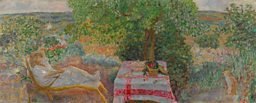Flower power: Monet and Matisse at the Royal Academy
30 January 2016
The Royal Academy's exhibition, Painting the Modern Garden: Monet to Matisse, explores how some of the biggest, green-fingered names of the art world dug deep to create beautiful, pastoral paintings. Featuring works from the likes of Monet, Renoir, Kandinsky and Matisse, the exhibition reveals a passionate relationship between the artists and nature. WILLIAM COOK reports.

While Britain is battered by winter storms, London’s Royal Academy is lit up by a sea of flowers. Painting the Modern Garden is a glorious display of light and colour, guaranteed to lift the gloomiest spirits, however dark and cold it is outside.
This lavish survey features dozens of great artists, but the star of the show is Claude Monet. ‘In my opinion, Monet was the greatest painter of gardens in the history of art,’ says William Robinson, Curator of Modern European Art at the Cleveland Museum of Art, and co-curator of this exhibition.
‘I perhaps owe it to flowers that I became a painter’Claude Monet
Monet was also a passionate gardener, and this show reveals his lifelong love of gardening was a vocation rather than a hobby.
‘I perhaps owe it to flowers that I became a painter,’ he reflected. From youthful still lives of cut flowers to his late, great paintings of his garden at Giverny, the domestic pastoral was a constant – and constantly evolving – theme.


‘Monet was a fantastic gardener,’ says Ann Dumas of the Royal Academy, who co-curated this show with William Robinson. ‘He is the artist-gardener par excellence.’
For these artists, like the rest of us, their gardens reflected their personalities.
Painting the Modern Garden charts the timeline of Monet’s life, from his early experiments with Impressionism to his mature ventures into Abstraction.
Yet what makes this show more than just another Monet retrospective is all the other artists (and gardeners) it incorporates along the way.
Several of Monet’s artistic friends also had green fingers. Camille Pissarro swapped gardening tips with Monet. Pierre Bonnard, another keen gardener, lived just a few miles away.
The curators illustrate these friendships with some fascinating juxtapositions. In the first room there’s a picture by Pierre-Auguste Renoir of Monet painting in his garden. Right beside it is the picture that Monet was painting at the time.
For these artists, like the rest of us, their gardens reflected their personalities.
Renoir adored wild gardens. Pissarro preferred more humdrum fruit and veg. Sneering critics called him ‘an Impressionist market gardener specialising in cabbages.’ Back then, such workaday subjects were seen as radical, even shocking.


Watch the exhibition trailer video


However when it came to gardening, or painting gardens, none of these artists could match Monet.
The Great War also cast a long shadow over Monet’s later life.
‘He reads more horticultural catalogues and price lists than articles on aesthetics,’ observed the French journalist Maurice Guillemot, after meeting the artist at Giverny.
‘Even when he was in rented accommodation he always made a garden,’ explains Ann.
One artist who ran him close was the German Impressionist Max Liebermann, who designed an idyllic garden for his summer villa on the shores of Lake Wannsee, near Berlin.
There are several paintings of Liebermann’s garden here - a delicate cluster of silver birches beside a vast expanse of silver water. You can still visit his garden today, if you’re ever in Berlin.
Painting the Modern Garden isn’t confined to the Impressionists.
There are some stunning paintings by Santiago Rusinol, full of the fierce heat and harsh light of Spain.
There are also a couple of charming pastorals by the German artist August Macke, who career was cruelly curtailed when he was killed in battle, in his twenties, at the beginning of the First World War.
The Great War also cast a long shadow over Monet’s later life. His son was fighting on the Western Front, and he could hear the gunfire from his studio in Giverny.
Many of his neighbours fled, but Monet soldiered on. ‘I’m staying here,’ he declared, defiantly, in 1914. ‘If those savages must kill me, it will be in the middle of my canvases, in front of all my life’s work.’
Monet’s career had stalled after the death of his wife in 1911, but now, in the midst of war, he created some of his most beautiful paintings, of water lilies floating in the pond he dug for them at Giverny.
More from BBC Arts
Art UK collections
-
![]()
Claude Monet
See 48 paintings
-
![]()
Pierre-Auguste Renoir
See 58 paintings
-
![]()
Henri Matisse
See 21 paintings
Related Links
Ironically, Monet’s fiercest opponents in this venture weren’t the Germans, but the local farmers, who worried these weird foreign plants would poison their cattle.
So why is there such a close relationship between so many artists and their gardens?
So why is there such a close relationship between so many artists and their gardens? Clearly, this isn’t a mere pastime. There’s something deeper going on.
‘The colour of the flowers drew me magnetically to them, and suddenly I was painting,’ observed the German Expressionist Emil Nolde, whose vivid flower paintings feature in this exhibition. Maybe, in a way, a garden is a sort of painting, an attempt to create the perfect picture, in the round.
The climax of this exhibition is an entire wall of Monet’s water lilies, known as the Agapanthus Triptych.
Monet painted these three pictures as a group - they were always meant to be hung together - but they’ve ended up in three separate galleries, in Cleveland, St Louis and Kansas City.
They’ve only been reunited once before, in America in 1954. This is the first time they’ve been seen together in Europe. It’s a fitting finale for this uplifting show, which makes you look at gardens in an entirely new and different way.

Painting the Modern Garden: Monet to Matisse is at London’s Royal Academy from 30 January to 20 April.
More from BBC Arts
-
![]()
Picasso’s ex-factor
Who are the six women who shaped his life and work?
-
![]()
Quiz: Picasso or pixel?
Can you separate the AI fakes from genuine paintings by Pablo Picasso?
-
![]()
Frida: Fiery, fierce and passionate
The extraordinary life of Mexican artist Frida Kahlo, in her own words
-
![]()
Proms 2023: The best bits
From Yuja Wang to Northern Soul, handpicked stand-out moments from this year's Proms








